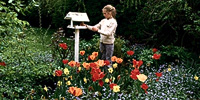
June 1, 1997
Garden Steps
Build Your Own
Now that the sun shines on a warmed land our minds and hands turn to garden chores. Perhaps this is the time for that much postponed task, building steps down a steep terrace. I did so when Kay no longer would descend to the lower level on the slippery grass. It turned out to be most simple, requiring only slabs of pebble encrusted concrete and bricks. For a while I toyed with the idea of a doubly curved series of steps but reconsidered when confronted with the problem of an equally curved hand railing. I took the easy way out, a straight set of steps.
The steps themselves are of cast concrete. Pebbles are embedded in one surface for both decoration and traction. The slabs are 18 inches deep, 24 inches wide and 2 inches thick. You may, if you wish, stain them a color other than concrete. I used a mixture of linseed oil thinned with a petroleum-based solvent(kerosene could also be used) and standard wood stain. The linseed oil helps prevent spalling ( surface peeling ) from moisture penetration and the alternate freezing and thawing of our Zone 5 weather. The wood stain is added judiciously. Remember that the color is much darker before the solvent evaporates.
The heavy clay soil ( ? ) we have provided an ideal firm base for the slab steps. The slope was excavated two steps and one riser at a time and the steps fitted one at a time. The bricks are the risers. Have the steps overhang the risers by about a half inch. If the slope is most gentle, the bricks used as risers may be laid face down.
Some sort of side support is required to prevent the earth from collapsing into the inside corner of the steps that are below ground level. I used strips of Backer Board. Backer Board is a sheet of concrete, nominally one half inch thick with both surfaces reinforced with cloth mesh. It is generally used in place of Gypsum wallboard to enclose wet areas such as tub or shower stalls. It must be cut with a power saw and a masonry-cutting blade. It really cuts most readily. In the absence of a power saw, you may use pressure treated lumber, certified for ground contact. The little drawing, below, shows the side earth support only on the right side, looking into the steps.
On one side of the steps I planted Cotoneaster. It requires continuous pruning to keep it from intruding into the steps. On the other side I terraced the slope with twenty-four inch wide slabs of Pennsylvania Bluestone imbedded into the earth with their eighteen-inch depth. This made a series of earthen steps for the planting of Chrysanthemums for a blaze of fall color. Kay can now descend to the lower part of the garden with ease and help pick the tomatoes.
|

Gardens Around The World
There are a lot of lists of links out there--some better than others. Try this one out. For example, click on the photos for Butchart Garden. They are better than shown elsewhere. They really get around the world. There are links to Arboreta, Botanical Gardens, Gardens and Herbariums arranged by country. In the US the extensive list is by sector and by state within each sector. There are also links to other garden lists.
Exotic Plant and Garden Seed Catalog
If you want some seeds for unusual plants and trees, this is for you You do not have to go to some exotic place, but can do your collection from home. Tropical plants a speciality from exotic houseplants and vines to trees, tropical fruit and nut plants. Included are rain forest plants, cacti and insect repellent plants. Grow your own Macadamia nut tree. Also contains a list of books.
Internet Directory for Botany
This is a massive listing of arboreta and worldwide botanical gardens arranged by country. Its ten pages list some that I have seen and many, many that I would like to visit. Botanic gardens in the US get the biggest play. I give it an extra check as it includes Cornell Plantations. This is where I first encountered Miscanthus sinensis. I now have some three dozen of these eight foot tall ornamental grasses in my own garden.
Botanique
Links to gardens and arboreta in the US and Canada are arranged by state and province. Some of the sites within a state are still empty but the list is extensive. There are links to gardening organizations, garden sites and even bullitin boards and newsgroups.
Arboreta, Musea, Plantations
Perhaps I am partial to this one as Cornell is my alma mater. In addition to its listing of Arboreta there are some for controlled environment agriculture. Well over a dozen years ago, the General Electric facility I worked at initiated this as a new business. Having fresh vine ripened tomatoes, cucumbers and lettuce in the middle of an upstate New York winter certainly beat out the rest of our products. Upper management did not agree and it was sold.
|
 Garden Adventures
Garden Adventures